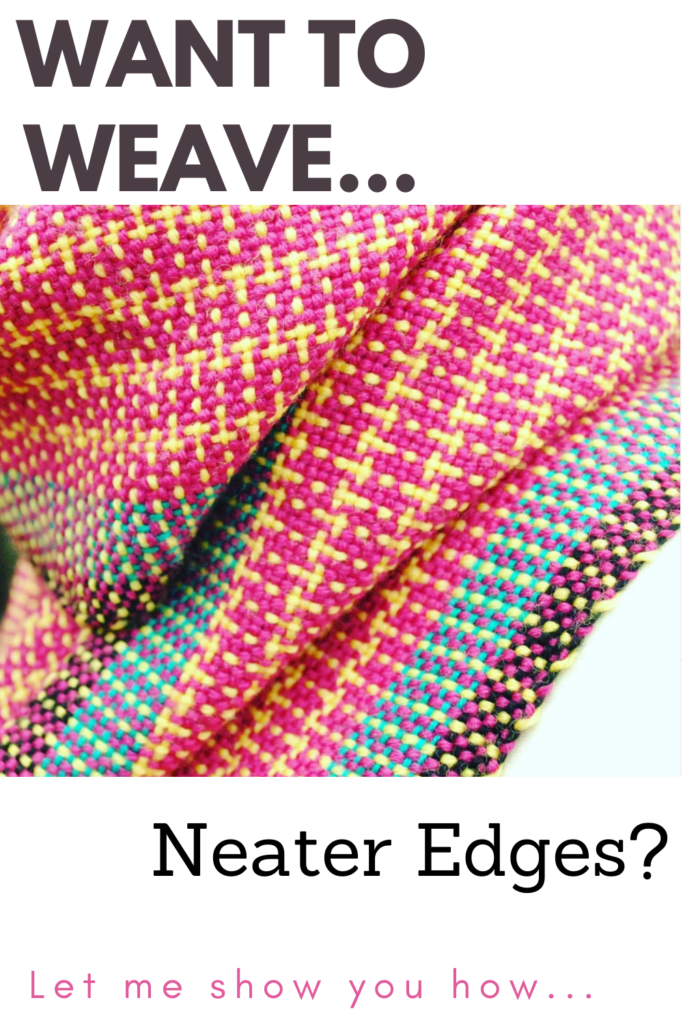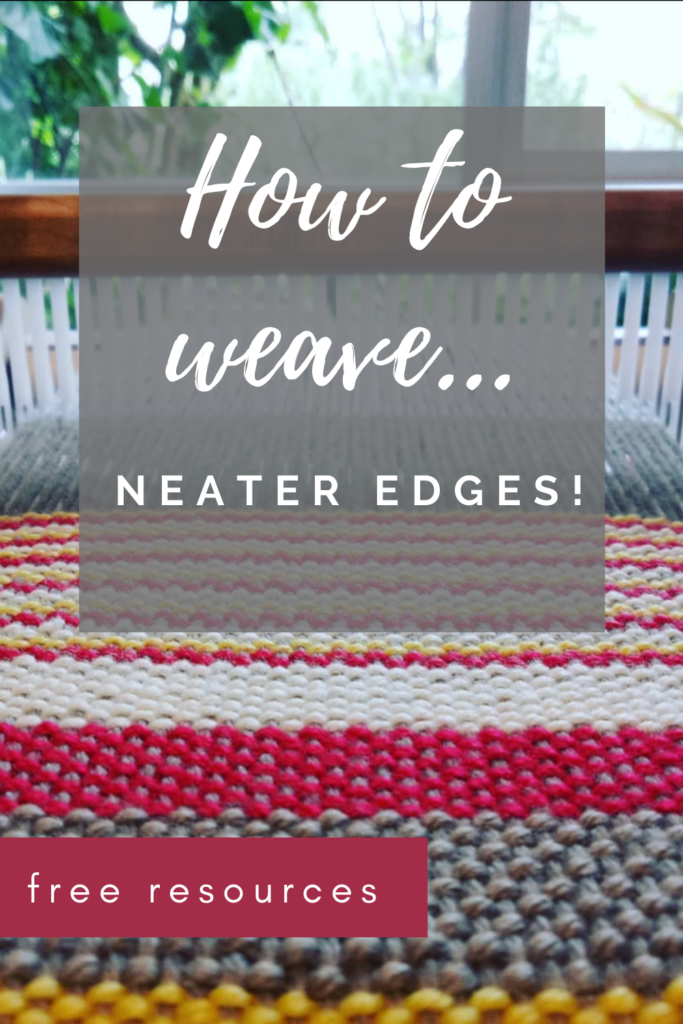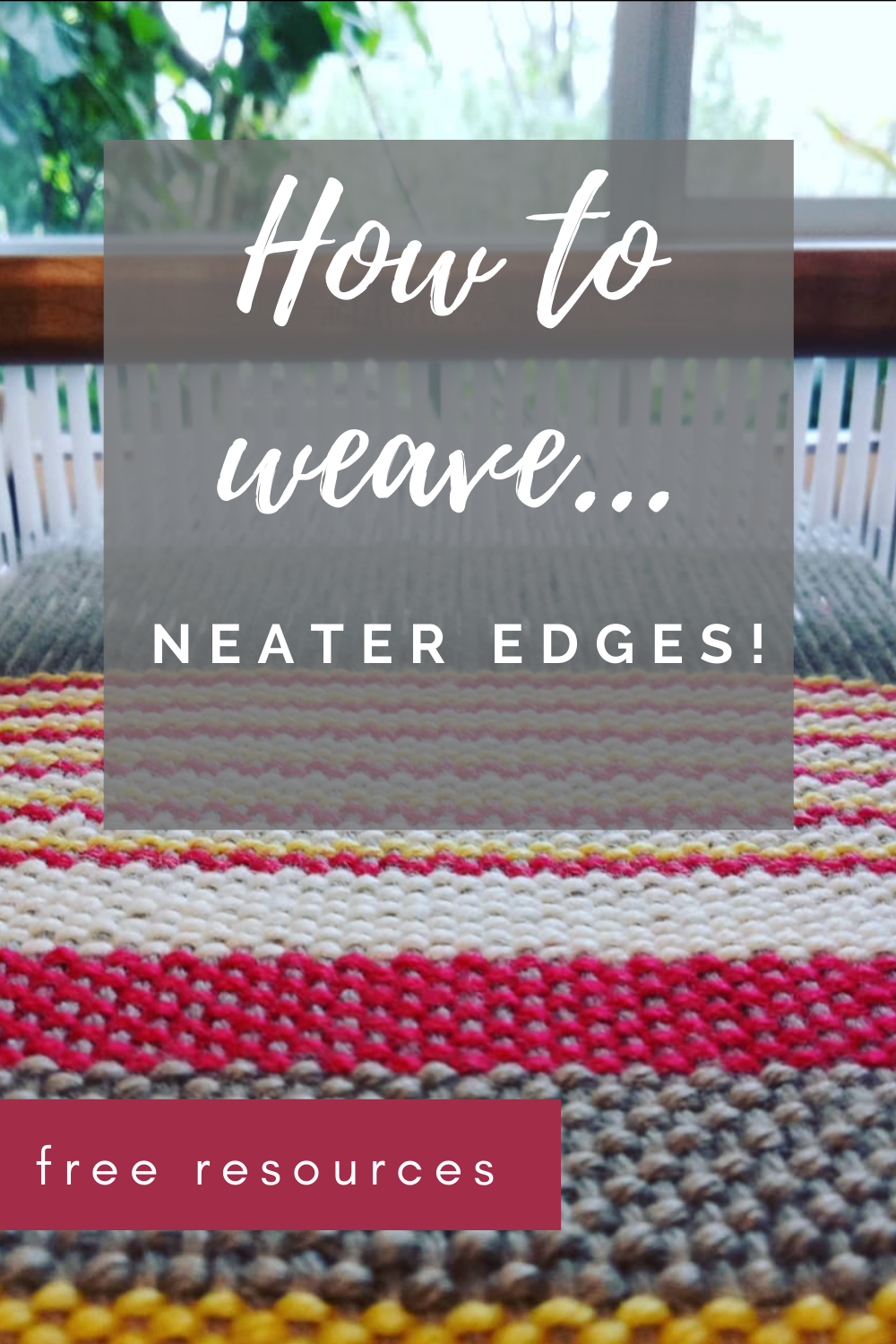The single biggest focus I’ve noticed that new weavers have is achieving straight edges. And not without reason. Let’s face it, how neat and professional a woven scarf looks depends a great deal on whether the edges are straight and attractive.
Let me start out by saying that I think there is maybe a little too much focus on the edges. I see so many newbies lamenting their weaving because the edges are not perfect. It would be a pretty rare event for a first time weaver to achieve near perfect edges. For most weavers, the problem improves very quickly with a bit of practice and knowledge of a few handy techniques.

There are some essentials to achieving neat edges.
- Correct warp tension
- Correct weft tension
Let’s talk about the warp tension first. Something that is quite common is that the weaver finds the tension is uneven across the warp, and typically the middle of the warp will be looser while the edge warp threads are tighter. If the edge warp threads are either too loose or too tight, the woven edges will be uneven and lumpy looking.
Combatting this problem begins when you are rolling the warp onto your loom. I’m referring here to direct warping a rigid heddle loom. If possible, have a helper to hold the end of the warp while you stand at the back of the loom and roll it on. The helper maintains the tension and makes the process easier. If you don’t have a helper, you can either weight the warp as it is rolled on or, if you are more experienced, hold the warp yourself but pay particular attention to maintaining even tension.

Then, when you come to tying or lashing the warp ends onto the front apron rod, ensure you have as consistent as possible tension across the width of the warp. I always say at this point, it doesn’t have to be tight – just consistent. The warp will tighten up when you advance the warp.
If all of this feels a bit advanced to you, I’m sure you would benefit immensely from my From Woe to Go – Beginner Rigid Heddle Weaving course.
Now, about the weft tension. This refers to how much tension you place on your weft thread as you weave it. Too much tension, and your edges will pull in. Too little tension and you will have loose loops sitting at the edges of your weaving. Neither of these are ideal. Over time, I’ve developed my own technique that I think is just about a perfect balance and that consistently gives me very neat edges. You can view the video for that here:
So far I’ve only been referring to edge maintenance for plain weave projects. If you are doing something with pick up sticks (which changes the weave structure) you will need a slightly different approach to neat edges and I talk about that in this post. There is also a companion video so that you can see the technique in action:
Floating selvedges are also an option and basically means that you add an extra end on either side of your warp that is not actually part of your warp, but becomes part of the finished weaving. I always use floating selvedges on my floor loom unless I’m weaving plain weave and it makes a huge difference. I have a member’s only class on how to set up floating selvedges over at my Online Weaving School.
Another instance where you may employ a different technique for your edges is when you are using more than one weft colour and need to decide whether you will cutting each time you change colour or whether you will carry the yarn up the sides. I also have a video demonstration of how to do that!
Another trick to try is to arrange your threading so that both of your edge warp threads are threaded in holes instead of one in a hole and one in a slot. The aim of this technique is to match the tension of the edge threads on both sides for more consistent looking edges.
I have a video tutorial on this method to show you exactly what to do:
And lastly, yet another technique to try (I told you it’s a popular topic!) is what I call my Lifeline technique. This works in a similar way to floating selvedges, except that you use fishing line and remove it when the weaving is finished. I have heard from a lot of happy weavers who say this techniques saved their project. Here is the video demonstration:
I hope this discussion has been a great help to you. Do you struggle with weaving neat edges? Let me know in the comments.
Until next time…
Happy Weaving!


What does it mean to double warp? Is that the best way to weave a dishcloth? And if Im weaving a dishcloth what size heddle should I use?
To double the warp is to warp a loop through ever hole and every slot, so you have twice as many threads as usual.
There are many ways to weave a dishcloth, it just depends on the thickness you want as to whether you double threads or not.
The heddle size will depend on the yarn size you want to use.
One selvage in a hole and the other in a slot was an “aha!” moment for me. Do you have a way to direct warp with a slot thread on each side? Thank you for all your wonderful lessons!
No, I haven’t done that Cynthia, you would have to do a bit of thread juggling to make it happen.
I wish I’d found this sooner, with my placemats that had a two shuttle change every pick but by trial and error I figure I did it right at least half the time. Next time I’ll do it right. Thanks for this for a reference. Love your classes.
Thanks for stopping by Tess! 😊
Love your teaching technique. Keep the classes coming. You are an inspiration!!
Thanks so much Dottie!
Thank you for putting this all together in one newsletter. Great reference materials. Definitely a keeper!
Thank you Robyn!